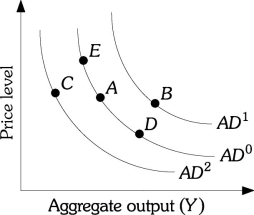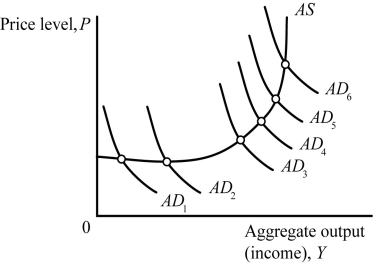Correct Answer

verified
Correct Answer
verified
True/False
In 2007, the Fed engaged in inflation targeting when it lowered the interest rate in anticipation of a recession.
Correct Answer

verified
Correct Answer
verified
Multiple Choice
In a binding situation, the ________ curve is ________.
A) AD; horizontal
B) AD; vertical
C) AS; horizontal
D) AS; vertical
Correct Answer

verified
Correct Answer
verified
Multiple Choice
When the AD curve is vertical
A) fiscal policy can be used to increase output.
B) monetary policy can be used to increase output.
C) both fiscal policy and monetary policy can be used to increase output.
D) neither fiscal policy nor monetary policy can be used to increase output.
Correct Answer

verified
Correct Answer
verified
Multiple Choice
Fiscal policy affects the ________ market through changes in taxes and government spending.
A) money
B) goods
C) federal funds
D) bond
Correct Answer

verified
Correct Answer
verified
True/False
A decrease in the Z factors represents an easing of monetary policy.
Correct Answer

verified
Correct Answer
verified
Multiple Choice
In a binding situation
A) only changes in the price level change the interest rate.
B) only changes in the Z factors change the interest rate.
C) changes in both the price level and in the Z factors change the interest rate.
D) the interest rate is always zero.
Correct Answer

verified
Correct Answer
verified
Multiple Choice
In a binding situation,there is ________ crowding out of planned investment when government spending increases.
A) complete
B) partial
C) no
D) negative
Correct Answer

verified
Correct Answer
verified
True/False
Expectations of higher future prices cause firms to lower prices today to sell their product before prices rise.
Correct Answer

verified
Correct Answer
verified
Multiple Choice
Which of the following is an example of an expansionary fiscal policy?
A) the Fed selling government securities in the open market
B) the federal government increasing the marginal tax rate on incomes above $200,000
C) the federal government increasing the amount of money spent on public health programs
D) the federal government reducing pollution standards to allow firms to produce more output
Correct Answer

verified
Correct Answer
verified
Multiple Choice
If the economy is on the steep portion of the AS curve and government spending increases, ________ crowds out ________.
A) consumption; planned investment
B) government spending; planned investment
C) planned investment; consumption
D) planned investment; government spending
Correct Answer

verified
Correct Answer
verified
Multiple Choice
If an increase in net taxes in the United States resulted in a very large decrease in aggregate output and a very small decrease in the price level, then the U.S. economy must have been
A) on the very steep part of the short-run aggregate supply curve.
B) on the very flat part of the short-run aggregate supply curve.
C) on the very steep part of the short-run aggregate demand curve.
D) on the very flat part of the short-run aggregate demand curve.
Correct Answer

verified
Correct Answer
verified
Multiple Choice
Refer to the information provided in Figure 27.1 below to answer the question(s) that follow.  Figure 27.1
-Refer to Figure 27.1. Suppose the economy is at Point A, a decrease in taxes can cause a movement to Point
Figure 27.1
-Refer to Figure 27.1. Suppose the economy is at Point A, a decrease in taxes can cause a movement to Point
A) E.
B) B.
C) C.
D) D.
Correct Answer

verified
Correct Answer
verified
Multiple Choice
The Fed generally had ________ interest rates in the 1970s and early 1980s to fight ________.
A) high; inflation
B) high; recession
C) low; inflation
D) low; recession
Correct Answer

verified
Correct Answer
verified
Multiple Choice
Refer to the information provided in Figure 27.2 below to answer the question(s) that follow.  Figure 27.2
-Refer to Figure 27.2. The output multiplier is largest when the aggregate demand curve shifts from
Figure 27.2
-Refer to Figure 27.2. The output multiplier is largest when the aggregate demand curve shifts from
A) AD1 to AD2.
B) AD3 to AD4.
C) AD5 to AD6.
D) The output multiplier is the same for all AD curve shifts shown in the figure.
Correct Answer

verified
Correct Answer
verified
True/False
If equilibria below potential output are self-correcting, the economy will spend a great deal of time on the horizontal part of the aggregate supply curve.
Correct Answer

verified
Correct Answer
verified
Multiple Choice
A binding situation occurred during the recession of
A) 1974-1975.
B) 1980-1982.
C) 1990-1991.
D) 2008-2009.
Correct Answer

verified
Correct Answer
verified
True/False
In a binding situation, a positive cost shock decreases output.
Correct Answer

verified
Correct Answer
verified
Multiple Choice
Refer to the information provided in Figure 27.2 below to answer the question(s) that follow.  Figure 27.2
-Refer to Figure 27.2. Planned investment would experience the least amount of crowding out when the aggregate demand curve shifts from
Figure 27.2
-Refer to Figure 27.2. Planned investment would experience the least amount of crowding out when the aggregate demand curve shifts from
A) AD1 to AD2.
B) AD3 to AD4.
C) AD5 to AD6.
D) The amount of crowding out is the same for all AD curve shifts shown in the figure.
Correct Answer

verified
Correct Answer
verified
Multiple Choice
Since 1970, the United States experienced stagflation
A) only after the recession of 1990-1991.
B) only in the 1970s and early 1980s.
C) throughout the 2000s.
D) only during the recession of 2008-2009.
Correct Answer

verified
Correct Answer
verified
Showing 161 - 180 of 200
Related Exams